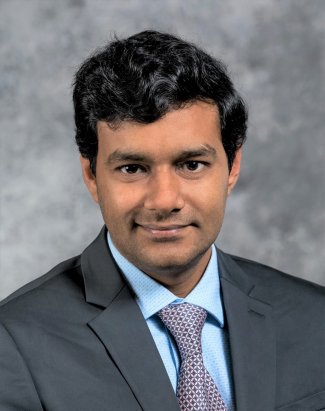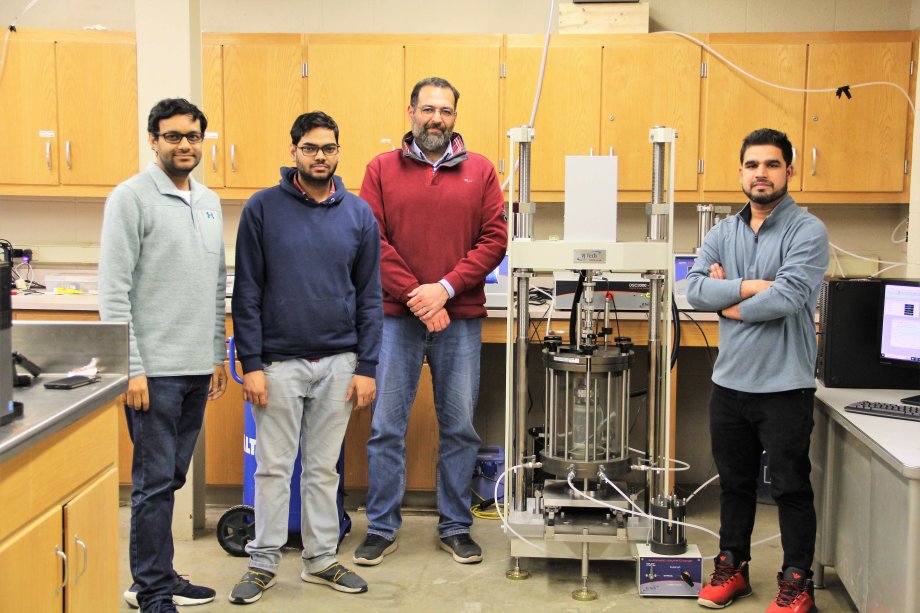Infrastructure—like roads, bridges, dams and airports—form the backbone of society and are essential to economic development. In 2021, the United States earned a "C-" grade from the American Society of Civil Engineers for its infrastructure. One of America's most critical sectors—roadways—earned a "D." It was a troubling sign that the country's key lifeline is crumbling.

While some representatives and lobbyists push for increased funding, researchers like Aritra Banerjee—an assistant professor in South Dakota State University's Department of Civil and Environmental Engineering—have begun exploring ways to improve the resiliency of roads by addressing a primary area of concern: problematic soils.
Banerjee's work is focused on finding natural ways to increase the "hardness" of soils that will prevent soil erosion and survive ever-increasing extreme weather events, like droughts.
One of Banerjee's ongoing projects is from the U.S. Department of Transportation’s University Transportation Centers program. He’s searching for ways to enhance the resiliency of pavement infrastructure in regions with sulfate-rich soils—like South Dakota.
Sulfate-rich soils, which are generally not measured when designing and building roadways, can cause swelling and severe damage to roads when lime or cement stabilization is used to improve weak soil subgrades. In some extreme cases, when rainfall occurs, a chemical reaction can cause the road above a sulfate pocket to warp, and in some cases, completely deform. Repairing roads are expensive and the cost is effectively taken on by the taxpayers. In general, this can increase the maintenance cost of vehicles and reduce rider’s comfort while driving on uneven roads.
In South Dakota, it is estimated that motorists are forced to pay over $500 a year in wasted time and fuel due to road damages, according to a 2021 ASCE report. Banerjee's work aims to find sustainable solutions for roads located in sulfate-rich regions.
"I'm trying to resolve or at least find out ways which can mitigate some of these major issues with problematic soils," Banerjee said.
Banerjee is currently looking at bio-inspired solutions.
"I'm looking at different types of materials that can be safely introduced to the soil," Banerjee said. "For example, when different types of bacteria clusters grow together, they are called biofilms, which could be a possible solution."
As Banerjee explains, biofilms will conjoin and form very hard, sturdy, skeletal-type structures. When added to the soil, Banerjee proposes biofilm could make soils more sustainable and able to withstand intense extreme weather events, like drought. He is paying particular attention to materials with microorganisms that can help with strength and health of soil that may benefit civil infrastructure like roads, embankments, levees and agriculture like mitigating effects of soil erosion and soil salinity on agricultural productivity.
"The formation of biofilms will help with strengthening the soil and should help mitigate erosion," Banerjee said. "It will help also help improve the soil health as well."
Agricultural professors at SDSU agree with Banerjee's assessments that the introduction of biofilms would be a positive for soil health. Other possible benefits include reduce costs due to thinner layers of pavement.
As Banerjee notes, studies in Argentina, Brazil, China and Egypt have introduced biofilms into the soil which increased the soil health and agricultural productivity on those lands. For his work, Banerjee will look at bacteria that can handle colder conditions and withstand South Dakota's long, harsh winters.
Recently, Banerjee was able to acquire a piece of equipment—an "advanced cyclic unsaturated triaxial" device from VJ Tech, Inc. based out of the United Kingdom—that will greatly increase the level of research his lab can conduct. The machine will allow the researchers to test soils in a variety of pressures and situations. They can also test its strength against extreme weather events—something that will be key in finding sustainable solutions.

SDSU is in a unique position as this piece of equipment is one of very few in the entire country.
Banerjee came to SDSU last fall, having previously spent time at the University of Delaware, Texas A&M University and the University of Texas at Arlington. He is currently a member of the Transportation Research Board committee on mechanics and drainage of saturated and unsaturated geomaterials and the ASCE's Geo-Institute's Committee on unsaturated soils, where is involved in creating an awareness of the importance of these fields in enhancing the resilience of critical and non-critical infrastructures in the U.S.
A prolific researcher, Banerjee has over 50 publications and over 500 citations from his publications.
This past semester, Banerjee taught three courses: geotechnical engineering, an undergraduate-level course; slope stability and earthen structures, a graduate-level course; and a geotechnical engineering lab.
- Contact:
- Telephone number: 605-688-6161
Republishing
You may republish SDSU News Center articles for free, online or in print. Questions? Contact us at sdsu.news@sdstate.edu or 605-688-6161.

